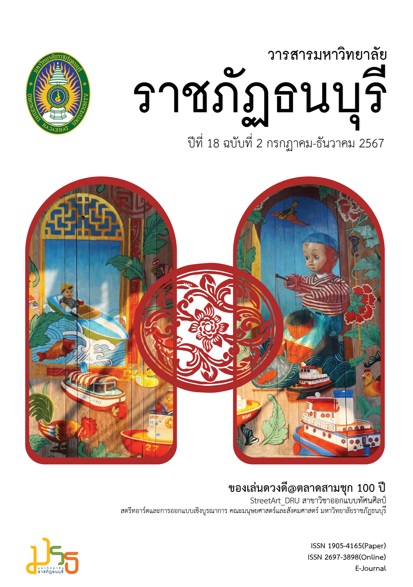The ฺMerit-Making Behaviors of Buddhists According to Puññakiriyavatthu at Wat Sangkhathan, Nonthaburi Province
Keywords:
Merit-making behaviors, Puññakiriyavatthu, Wat Sangkhathan, Nonthaburi ProvinceAbstract
The objectives of this research were 1) to study the merit-making behaviors of Buddhists according to Puññakiriyavatthu at Wat Sangkhathan, Nonthaburi Province and 2) to compare the merit-making behaviors of Buddhists according to Puññakiriyavatthu at Wat Sangkhathan, Nonthaburi Province, based on personal factors. This was quantitative research involving a sample group of 361 people, using the R.V. Krejcie and D.W. Morgan population ratio formula. Data were analyzed using descriptive statistics including frequency, percentage, mean, and standard deviation, and inferential statistics included t-tests, One-Way ANOVA, and pairwise comparison of means using the least significant difference method. The research findings revealed that 1) the Buddhists’ merit-making behaviors according to Puññakiriyavatthu at Wat Sangkhathan, Nonthaburi Province, were generally at a high level (M = 3.58, SD = 0.55). When categorized by aspect, the merit-making behavior scores according to Puññakiriyavatthu were at a high level in two areas: the aspect of precepts (M = 4.13, SD = 0.66) and the aspect of meditation (M = 3.71, SD = 0.80). The interpretation of the results was at a moderate level in the aspect of generosity (M = 2.90, SD = 0.66), which was statistically significant at the 0.05 level; 2) the comparison of merit-making behavior among the sample groups with different genders, marital statuses, monthly incomes, education levels, and occupations showed no difference in merit-making behaviors according to Puññakiriyavatthu, which did not support the hypothesis. However, the sample groups with different ages and merit-making experiences showed differences, which supported the hypothesis.
Downloads
References
กันตภณ หนูทองแก้ว. (2556). การนำหลักบุญกิริยาวัตถุมาใช้ในวิถีชีวิตของประชาชน อำเภอเมือง จังหวัดนครศรีธรรมราช พ.ศ. 2556. สารอาศรมวัฒนธรรมวลัยลักษณ์. 15(1), น.165.
กิตติกร เกื้อกูล (ปากกาสีเงิน). (2556). เบิกบานพุทธวิถีเพื่อความงดงามของชีวิต. กรุงเทพมหานคร : บริษัทรุ่ง แสงการพิมพ์ จำกัด.
จรัสลักษณ์ ทองโอฬาร. (2564). แนวทางการเสริมสร้างความรับผิดชอบต่อสังคมตามหลักบุญกิริยาวัตถุ. วิทยานิพนธ์ปริญญาพุทธศาสตร์มหาบัณฑิต สาขาหลักสูตรพุทธศาสตร(พระพุทธศาสนา) บัณฑิตวิทยาลัย มหาวิทยาลัยมหาจุฬาลงกรณราชวิทยาลัย.
พระแวงชัย ธมฺมกาโม, พระมหาบุญไทย ปญฺญมโน, และคณะ. (2562). การพัฒนาคุณภาพชีวิตด้วยบุญกิริยาวัตถุ. วารสารวิจัยราชภัฎพระนคร สาขามนุษย์ศาสตร์และสังคมศาสตร์. 14 (1), น.199-201.
พระกิตติพันธ์ กิตฺติพโล. (2563). วิเคราะห์บทบาทในการบำรุงพระพุทธศาสนาของอุบาสกอุบาสิกา : กรณีศึกษาตำบลลำปางหลวง อำเภอเกาะคา จังหวัดลำปาง. วารสารพุทธศาสตร์ศึกษา. 11( 2), น. 462-463.
พระครูปลัดกิตติวัฒน์ (เมธวัจน์ สีลภูโต). (2560). การปฏิบัติบุญกิริยาวัตถุของพุทธศาสนิกชน : ศึกษาเฉพาะกรณีพุทธศาสนิกชนวัดบางนานอก. วิทยานิพนธ์ปริญญาพุทธศาสตรมหาบัณฑิต สาขาพระพุทธศาสนาบัณฑิตวิทยาลัย มหาจุฬาลงกรณราชวิทยาลัย.
พระครูสุธีคัมภีรญาณ, และพระมหาสำรอง สญฺญโต. (2562). การส่งเสริมพฤติกรรมที่พึงประสงค์ของคนในครอบครัวด้วยการรักษาอุโบสถศีลของชุมชนชาวพุทธในเขตเทศบาลขอนแก่น. วารสารบัณฑิตศึกษามหาจุฬาขอนแก่น. 6(4), น.891.
พระพีรญาภพพ์ ธารพนาลี. (2563). ศึกษาวิเคราะห์ วิมานในวิมานวัตถุ. วารสารมนุษยศาสตร์ มหาวิทยาลัยนเรศวร. 17(1), น. 71.
พระภัทรนันต์ ฐิตเสฏฺโฐ, และคณะ. (2559). ศึกษาวิเคราะห์บุญกิริยาวัตถุ 3 ที่ปรากฏในคัมภีร์อรรถกถาธรรมบท. วารสารปัญญาปณิธาน. 1(1), น. 22-28.
พระสมภพ โชตปัญโญ. (2559). บุญ ทาน น่าอัศจรรย์จริง. กรุงเทพมหานคร : ห้างหุ้นส่วนจำกัด แอลซีพี ฐิติพรการพิมพ์.
พระสาธิต รกขิตวํโส (เขื่อน คำแสน), และพระอธิการสมนึก จรโณ. (2564). ศึกษาวิเคราะห์วัตถุทานใพระพุทธศาสนาเถรวาท. วารสารวิทยาลัยสงฆ์นครลำปาง. 11(2), น. 4.
พาสนา สกุลอิสรยาภรณ์. (2564). การศึกษาแรงจูงใจในการทำบุญของชาวพุทธ ที่วัดชลประทานรังสฤษฎ์ จังหวัดนนทบุรี. วารสารวิชาการสถาบันพัฒนาพระวิทยากร. 6(2), น.227.
พิชาณันช์ เตชะประสิทธิวานิช. (2562). การปฏิบัติตนตามหลักบุญกิริยาวัตถุ 10 ของพุทธศาสนิกชน วัดไร่ขิง จังหวัดนครปฐม. วารสาร มจร พุทธปัญญาปริทรรศน์. 4(2), น.31-32.
ลักษณวัต ปาละรัตน์. (2563). การใช้หลักศาสนธรรมในพระพุทธศาสนาเพื่อการพัฒนาตน: กรณีศึกษานักศึกษาที่เข้าเรียนวิชาพระพุทธศาสนาเบื้องต้น มหาวิทยาลัยรามคำแหง. วารสารวิจัยรามคำแหง (มนุษยศาสตร์และสังคมศาสตร์). 23(2), น. 33.
สำนักเลขาการสภาการศึกษา กระทรวงศึกษาธิการ. (2561) รายงานการศึกษาไทย พ.ศ. 2561 (Education in Thailand 2018). กรุงเทพมหานคร : บริษัท พริกหวานกราฟฟิค จำกัด.
สำนักงานคณะกรรมการพัฒนาเศรษฐกิจและสังคมแห่งชาติ สำนักนายกรัฐมนตรี. (2564). แผนพัฒนาเศรษฐกิจและสังคมแห่งชาติ ฉบับที่ 12 (พ.ศ. 2560 – 2564). ค้นเมื่อ 20 กันยายน 2566 จาก http://plan.bru.ac.th.
สิทธิโชค วรานุสันติกุล. (2531). จิตวิทยาการจัดการพฤติกรรมมนุษย์. (พิมพ์ครั้งที่ 2). กรุงเทพมหานคร : อักษรพิพัฒน์.
มหาจุฬาลงกรณราชวิทยาลัย. (2539). พระไตรปิฎกภาษาไทย ฉบับมหาจุฬาลงกรณราชวิทยาลัย. กรุงเทพมหานคร : โรงพิมพ์มหาจุฬาลงกรณราชวิทยาลัย.
Kohlberg, L. (1969). Stages and Sequence: The Cognitive Developmental Approach to Socialization Handbook of Socialization Theory and Research. Chicago : Rand McNaiiy and Company.
Downloads
Published
How to Cite
Issue
Section
License
Copyright (c) 2024 Dhonburi Rajabhat University

This work is licensed under a Creative Commons Attribution-NonCommercial-NoDerivatives 4.0 International License.
บทความที่ได้รับการตีพิมพ์เป็นลิขสิทธิ์ของ มหาวิทยาลัยราชภัฏธนบุรี
ข้อความที่ปรากฏในบทความแต่ละเรื่องในวารสารวิชาการเล่มนี้เป็นความคิดเห็นส่วนตัวของผู้เขียนแต่ละท่านไม่เกี่ยวข้องกับมหาวิทยาลัยราชภัฏธนบุรีและบุคลากรท่านอื่นๆในมหาวิทยาลัยฯ แต่อย่างใด ความรับผิดชอบองค์ประกอบทั้งหมดของบทความแต่ละเรื่องเป็นของผู้เขียนแต่ละท่าน หากมีความผิดพลาดใดๆ ผู้เขียนแต่ละท่านจะรับผิดชอบบทความของตนเองแต่ผู้เดียว






